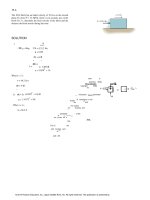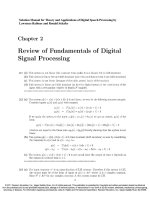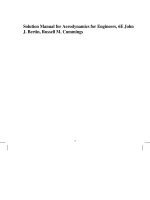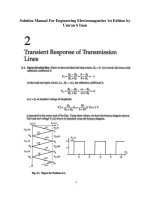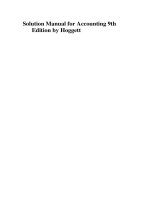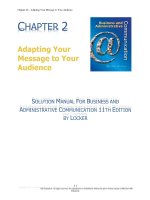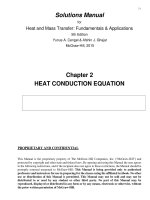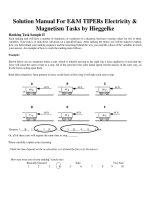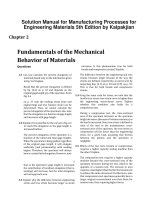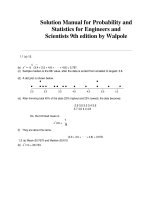link full download solution manual for accounting 9th edition by hoggett
Bạn đang xem bản rút gọn của tài liệu. Xem và tải ngay bản đầy đủ của tài liệu tại đây (2.06 MB, 97 trang )
Solution Manual for Accounting 9th
Edition by Hoggett
Chapter 2: Financial statements for decision making
© John Wiley & Sons Australia, Ltd 2015
© John Wiley & Sons Australia, Ltd 2015
2.1
Solutions Manual to accompany Accounting 9e by Hoggett et al
CHAPTER 2
FINANCIAL STATEMENTS FOR DECISION MAKING
DISCUSSION QUESTIONS
SOLUTIONS
1.
Explain the basic differences between a sole trader (or single proprietorship), a
partnership and a company. Discuss the factors that need to be considered in
selecting an appropriate structure for Cynthia’s beauty services business.
The three basic business structures are:
Sole traders are where individuals conduct business in their own capacity. They would be
contributing their own capital or equity to the business and would be borrowing money in the
name of the business in their own name. They would be liable to repay the outstanding debt of
the business and, if unable to repay, the bank, would have access to their own personal assets
to repay the outstanding debt. This business structure is suitable for small operations with
small staff and turnover. The sole trader has sole responsibility and control for the business
operations and activities. This structure is suitable for small businesses which require minimal
capital to set up and have relatively low running costs and risk.
A partnership is two or more persons in business together, operating under a partnership
agreement which may or may not be a formally written document. Partnerships have the
advantage over sole traders in that they have a larger base for capital contribution and are able
to share the risks and responsibilities associated with running a business. The partnership is
treated as a separate entity for accounting purposes but is not a separate legal entity. This
means that the underlying assets and liabilities of a partnership belong to the individual
partners in the proportion agreed upon as part of the partnership agreement. Therefore if the
business activities prove to be unsuccessful, creditors have the right to access the personal
assets of the individual partners in the event the business is unable to repay any outstanding
debt. For this reason, the partnership structure is usually used where there is a low element of
risk to the business or where the law dictates that the business entity must be run by the
individuals providing the service. For example, work completed by professionals including
accountants and lawyers.
The company is a separate legal entity with ownership of a company attributed to shares held.
The owners of the company are known as shareholders. The advantage of this business
structure is that, as a separate legal entity, the assets and liabilities belong to the company. In
the event the business is unable to repay its debt, the creditors only have access to company
assets for repayment of the debt. The investment in the company by its shareholders is limited
only to the shareholders’ capital contribution, i.e. what the shareholder pays for the shares.
This business structure is more appropriate for entities requiring larger capital contribution,
which have a large number of overheads and employees and has a higher business risk. The
disadvantages include higher set up and ongoing costs and possible reduction in control over
the business operations where shareholders are not directly involved in the business
operations.
© John Wiley & Sons Australia, Ltd 2015
2.2
Solutions Manual to accompany Accounting 9e by Hoggett et al
Factors that Cynthia needs to consider in selecting an appropriate structure for her business
include:
simplicity in setting up the business
Sole traders and small partnerships are easier to set up compared to companies.
establishment costs
Companies are more expensive to establish compared to sole traders and partnerships.
liability issues
Sole traders and partnerships have unlimited liability, which means owners and partners
are personally liable for their business’ debts, including those resulting from lawsuits or
the actions of other partners. If unlimited liability is a concern, then Cynthia may want to
consider setting up a company instead of being a sole trader or partnership.
tax
Tax reporting requirements for companies are far greater than for sole traders and
partnerships.
control of the business
As an owner of a sole trader, Cynthia would have a complete control over her business.
If she chooses to partner with someone through a partnership, she will need to discuss
business matters with her partner. If Cynthia decides to set up a company and employs a
management team, she may not have as much control in running the business as it will
be the responsibility of the management team.
access to capital
The access to finance for a sole trader is limited to the owner’s resources. On the other
hand, a partnership has greater access to capital from resources of all partners, and a
company has even far greater access to capital from various shareholders.
Oxfam is a ‘not-for-profit’ entity. Discuss what it means to be a ‘not-for-profit’
entity.
The Australian accounting standards define a not-for-profit entity as ‘an entity whose
principal objective is not the generation of profit’ (AASB 136 para. Aus6.2). This means that
a not-for-profit entity can still generate profits, however any profit generated by the entity
must be used to further the entity’s objectives rather than serve the interests of the members or
owners. For example, Oxfam is a not-for-profit entity as any surplus or profit made from its
operations will be used to achieve its purpose, which is to create lasting solutions in order to
free people from poverty.
2.
For tax purpose, not-for-profit entities in Australia can be categorised as charities (such as
Oxfam), income tax exempt funds, and other not-for-profit organisations (such as sporting
clubs and community service groups). Performance of not-for-profit entities can be assessed
by comparing their activities to their stated goals for the period.
3.
Entities are expected to perform in the spheres of profit, people and the planet. List
some key performance indicators applicable to each sphere.
The sphere of profit relates to financial performance and business strategies of the entities.
Examples of key performance indicators under the profit sphere include:
profit margin;
profit after tax;
return on assets;
return on equity;
asset turnover;
© John Wiley & Sons Australia, Ltd 2015
2.4
Chapter 2: Financial statements for decision making
EPS growth;
sales growth
The sphere of people relates to the entities’ employees and involvement in the community.
Examples of key performance indicators under the people sphere include:
employee turnover rate;
employee absenteeism;
number of work place accidents;
percentage of female employees;
donations to charities;
programs run by the entities for the community.
The sphere of planet relates to the impact of the entities’ operations on the environment.
Examples of key performance indicators the planet sphere include:
carbon gas emissions;
water and electricity usage;
recycling program;
waste management.
4.
The coach of the local football team was trying to motivate the team before a big
match. He said: ‘Our team is like any organisation. We must have goals, we must
practise the usual management functions, and we must make use of all relevant
information’. Do you agree with the coach? Explain your position.
The management of a sporting team must have goals, e.g. winning, putting up a good
performance, reputation, character-building of team members and recruitment of new
members.
The management of a sporting team must plan, organise, direct, and control the team’s efforts
and generally operate like any other business organisation.
In order to plan team performance, the coach would need some relevant available information
to plan performance, develop a game plan, direct play during the match, and gather
information so that an analysis of the game may lead to improved future performance.
Some discussion could take place on how a team would operate without such management
principles being used.
5.
Analyse why the cash received from the sale of a good is income yet the cash
contributed by the owner is not income.
The Conceptual Framework defines income as ‘increases in economic benefits during the
accounting period in the form of inflows or enhancements of assets or decreases of liabilities
that result in increases in equity, other than those relating to contributions from equity
participants’ (para. 70(a)). In other words, for an item to be classified as income, there must
be increases in economic benefits which result in increases in equity, and the increases in
economic benefits must not come from owners. Both cash from sale of a good and cash
contributed by owner are increases in economic benefits which increase equity. However,
cash contributed by the owner is not income as it is a form of contributions from equity
participants (i.e. the owner), whereas cash from sale of a good is income as it does not come
from the owner but from customers.
© John Wiley & Sons Australia, Ltd 2015
2.5
Solutions Manual to accompany Accounting 9e by Hoggett et al
6.
Discuss whether an asset needs to be legally owned to be recorded as an asset on the
balance sheet.
Assets are defined in the Conceptual Framework as ‘resources controlled by the entity as a
result of past events and from which future economic benefits are expected to flow to the
entity’ (para. 49(a)). That is, to be recorded as assets, the entity must have the ability to
benefit from the use of the assets and deny access of others to the benefits (i.e. control).
Although, in most cases, legal ownership will give the entity control over an asset, certain
types of lease arrangements can result in the entity controlling the asset. For example, finance
leases transfer the risks and benefits of ownership to the lessee, which means the leased asset
is now controlled by the lessee. Subsequently, the leased asset should be recorded as an asset
on the lessee’s balance sheet, even though the lessee does not legally own the asset just yet.
Furthermore, following the qualitative characteristics of faithful representation in the
Conceptual Framework, it is important that the economic substance rather than the legal form
of the transaction is reported. In a finance lease, legal title to the leased asset still remains with
the lessor until the end of the relevant lease term when the lessee has made all lease payments.
However, the lessee has use of and earns economic benefits from the leased asset for this time
period (i.e. economic substance), and hence the leased asset should be recorded as an asset in
the lessee’s balance sheet during the period of the lease term.
In summary, an asset does not need to be legally owned by the entity to be recorded as an
asset on the balance sheet. As long as the entity controls the asset, then the asset must be
reported on the entity’s balance sheet.
7.
A local football club has won the premiership for the past four years. Accordingly,
the club has a very strong supporter base. Rationalise if the players would be
regarded as an asset of the business to be recognised on the balance sheet.
To be recognised as an asset on the balance sheet, an item must satisfy definition and
recognition criteria specified in the Conceptual Framework. An asset is defined in the
Framework as a resource controlled by the entity as a result of past events and from which
future economic benefits will flow to the entity. The three definition criteria must be satisfied
if the players were to be recognised on the balance sheet as assets to the football club:
future economic benefits
The players do provide future economic benefits to the football club through the use of
their skills. The benefits could be in the form of ticket sales to see the players, winning
the premiership, strong supporter base, product’s endorsements, sponsorships, etc.
control
Control is the ability to benefit from the use of the assets and deny access of others to
the benefits. It could be argued that the football club does not have sufficient control
over its players. Although the players might have signed a contract with the club, they
can still leave the club and play somewhere else. The club does not own its players and
the players’ skills that are used to generate future economic benefits ultimately belong
to the players, not the club.
past events
These are past transactions that give rise to control. Since the football club does not
have control over its players, there is no past transaction that gives rise to control.
Signing a contract or giving a lump sum amount as ‘advance payment’ does not give
the club control over the players.
© John Wiley & Sons Australia, Ltd 2015
2.6
Chapter 2: Financial statements for decision making
In addition to the definition criteria, two recognition criteria must also be satisfied for an asset
to be recorded on the balance sheet:
probable occurrence
This means that the future economic benefits are more like (than less likely) to flow
into the football club. It can be argued that future economic benefits as mentioned
above are likely to flow to the club as a result of players using their skills.
reliable measurement
To be recognised on the balance sheet, the players must have value that can be
measured with reliability. In this case, there is no reliable system that can be applied to
measure how much players are worth. Each player is unique, and hence it is very
difficult to assign an objective value to each player.
To be recorded on the financial statements, all criteria must be satisfied. From the explanation
above, it can be seen that players do not satisfy the definition and recognition criteria of
assets. Subsequently, they cannot be recorded as assets on the balance sheet. It should be
noted that it is not necessary to work through the recognition criteria if it is determined that
the item does no satisfy the definition criteria. All aspects of the definition and recognition
criteria must be satisfied for the item to be recognised on the balance sheet.
8.
As the accountant at a local council, explain to the Chief Executive Officer if the land
under roads is an asset that should be recorded on the Council’s balance sheet.
AASB 1051 Land Under Roads prescribes that an entity may elect to recognise (subject to
the satisfaction of asset recognition criteria) or not to recognise as an asset land under roads
acquired before the end of the first reporting period ending on or after 31 December 2007.
The final decision of whether to recognise or not shall be made effective as at the first day of
the next reporting period following the end of
the first reporting period ending on or after 31 December 2007.
Assuming the Council has a reporting period ending 30 June, AASB 1051 mandates that the
Council is required to choose whether it would recognise (or not) land under roads acquired
on or before 30 June 2008. Land acquired after 30 June 2008 is to be treated as an asset of the
Council in accordance with the AASB 116 Property Plant & Equipment.
9.
Moonshine Enterprises hired an accountant at the rate of $1000 per week. The
person is to commence duty on 1 February. Explain if the business has a liability in
respect of the accountant’s salary as at 1 February.
Suggested topics for discussion re Moonshine Enterprises:
On 1 February, the business does not have a liability because, at this stage, they are not
presently obliged to sacrifice future economic benefits (his/her wage paid in cash), i.e. not
until the expense has occurred, which isn’t recognised until it is probable that the
consumption has occurred and can be measured reliably.
The contract remains unperformed by both parties until the work is completed by the
employee.
© John Wiley & Sons Australia, Ltd 2015
2.7
Solutions Manual to accompany Accounting 9e by Hoggett et al
10.
Discuss the significance of the following assumptions in the preparation of an entity’s
financial statements:
(a) entity assumption
(b) accrual basis assumption
(c) going concern assumption
(d) period assumption
(a) Entity Assumption:
If the transactions of an entity are to be recorded, classified and summarised into
financial statements, the accountant must be able to identify clearly the boundaries of
the entity being accounted for. Under the accounting entity assumption, the entity is
considered a separate entity distinguishable from its owner and from all other entities.
It is assumed that each entity controls its assets and incurs its liabilities. The records
of assets, liabilities and business activities of the entity are kept completely separate
from those of the owner of the entity as well as from those of other entities.
The accounting entity assumption is important since it leads to the derivation of the
accounting equation.
(b) The Accrual Basis Assumption
Under the accrual basis of accounting, the effects of transactions and events are
recognised in accounting records when they occur, and not when the cash is received
or paid. Hence, financial statements report not only on cash transactions but also on
obligations to pay cash in the future and on resources that represent receivables of
cash in future. It is argued in the Conceptual Framework that accounting on an
accrual basis provides significantly better information about the transactions and other
events for the purpose of decision making by users of financial statements than does
the cash basis.
(c) The Going Concern Assumption
According to the Conceptual Framework, financial statements are prepared on the
assumption that the existing entity is expected to continue operating into the future. It
is assumed that the assets of the entity will not be sold off and that the entity will
continue its activities; hence, liquidation values (prices in a forced sale) of the entity’s
assets are not generally reported in financial statements, as this assumes that an entity
is to be wound up.
When management plans the sale or liquidation of the entity, the going concern
assumption is then set aside and the financial statements are prepared on the basis of
estimated sales or liquidation values. The significance of the going concern
assumption is in the valuation placed on the assets of an entity in the entity’s financial
statements. The statements should identify clearly the basis upon which asset values
are determined — going concern? Or liquidation?
(d) The Period Assumption
For financial reporting purposes, it is assumed that the total life of an entity can be
divided into equal time intervals. Hence, the financial performance of the entity can
be determined for a given time period, and the financial position of the entity can be
determined on the last day of that reporting period.
As a result of this assumption, profit determination involves a process of recognising
the income for a period and deducting the expenses incurred for that same period.
Together, the period assumption and accrual basis assumption lead to the requirement
for making end-of-period adjustments on the last day of the reporting period. These
adjustments will be considered in chapter 4.
© John Wiley & Sons Australia, Ltd 2015
2.8
Chapter 2: Financial statements for decision making
11.
List and define the fundamental and enhancing characteristics of financial
information.
The two fundamental characteristics of financial information are:
relevance
Relevance means that the information contained in financial statements is able to
influence the economic decisions made by users. For example, the information may
help users to predict future events, such as future cash flows, from alternative courses
of action under consideration. Also, information is relevant if it is able to help decision
makers evaluate past decisions. The information may confirm that a previous decision
was correct, or it could show that the results of a previous decision were undesirable
and that a new decision is necessary. Thus, relevant information is said to play a
predictive role and a confirmatory or feedback role.
faithful representation
Faithful representation is attained when the depiction of an economic event is complete
(i.e. all information necessary to represent the event are included), neutral (i.e. free
from bias), and accurate (i.e. free from material error). In addition, financial
information that faithfully represents an economic phenomenon should depict the
economic substance of the underlying transaction, event or circumstances, rather than
its legal form.
The four enhancing characteristics of financial information are:
comparability
Comparability is the quality of information that enables users to identify similarities in
and differences between two sets of economic data. For financial information to be
comparable, users need to be able to compare information of an entity over time, and
between entities at one time and over time.
verifiability
If financial information is verifiable, it means that different independent observers
would reach general agreement that the information represents economic event it
purports to represent without material error or bias.
timeliness
To be relevant for decision-making, financial information must be available in a timely
manner. If there is undue delay in reporting the information to users, then the
information will lose its capacity to influence decisions (i.e. no longer relevant).
understandability
The Conceptual Framework defines understandability as the quality of information that
enables users who have a reasonable knowledge of business and economic activities
and financial accounting, and who study the information with reasonable diligence, to
comprehend its meaning.
12.
Distinguish between the concepts of consistency and comparability and discuss if the
same accounting method should always be applied consistently in financial
statements.
The IASB Exposure Draft An Improved Conceptual Framework for Financial Reporting:
Chapter 2: Qualitative Characteristics and Constraints of Decision-useful Financial
Reporting Information, issued in May 2008, describes comparability as an enhancing
characteristic of information i.e. it enhances the usefulness of financial reporting information
in making economic decisions. Comparability is the quality of information that enables users
© John Wiley & Sons Australia, Ltd 2015
2.9
Solutions Manual to accompany Accounting 9e by Hoggett et al
to identify similarities in and differences between two sets of economic data. Consistency
refers to use of the same accounting policies and procedures, either from period to period
within an entity or in a single period across entities. The Exposure Draft argues that
comparability is the goal, and that consistency of policies and procedures is a means to an end
that helps to achieve the goal. However, it is not satisfactory for policies and procedures to be
applied consistently if the information that they produce is no longer relevant or a faithful
representation of economic reality.
13.
Your doctor knows that you are studying accounting. He has recently received the
annual report for a company in which he is a shareholder. The financial report
within the annual report is lengthy and your doctor requests your advice as to
whether he should contact the company to complain that the financial information is
not understandable. Advise your doctor.
According to the Conceptual Framework, understandability is the quality of information
which enables users who have a reasonable knowledge of business and economic activities
and financial accounting, and who study the information with reasonable diligence, to
comprehend its meaning. It should be clear that, even though it is desirable for financial
statements to be expressed in simple language, relevant information should not be excluded
merely because it may be too complex or difficult for some untrained users to understand.
Understandability does not mean simplicity. If users cannot understand the information
contained in financial statements, they should seek the help of a trained adviser. Therefore, it
is advised that the doctor should not contact the company to complain that the financial report
is not understandable. Instead, he should seek help from his accountant or financial planner to
help him understanding the information in the financial report.
14.
Management expert Professor Henry Mintzberg has argued that a manager’s work
can be characterised by ten common roles falling into three categories: informational
(managing by information), interpersonal (managing through people), and decisional
(managing through action). Provide an example of activity in each of these three
categories.
The informational category (managing by information) involves managers’ roles in
processing information. Examples of activities under the informational category include:
seeking out information related to the organisation and
industry, and looking for relevant changes in
the environment in which the organisation operates;
monitoring employees in terms of their productivity and well-being;
communicating potentially useful information to colleagues and employees;
transmitting information
about the organisation to people outside the organisation (i.e. being a
spokeperson).
The interpersonal category (managing through people) involves managers’ roles in providing
information and ideas. Examples of activities under the interpersonal category include:
providing leadership to the team or organisation;
managing performance and responsibilities of employees within the organisation;
providing inspiration to subordinates and being a figurehead;
building effective networking with people inside and outside the organisation.
The decisional category (managing through action) involves managers’ roles in using
information. Examples of activities under the decisional category include:
© John Wiley & Sons Australia, Ltd 2015
2.10
Chapter 2: Financial statements for decision making
generating new ideas and implementing them;
15.
solving problems and mediating disputes;
allocating resources;
taking part in negotiations.
‘Faithful representation’ is a fundamental characteristic of financial information.
This term replaced ‘reliable’ in the 2010 revisions to the Conceptual Framework.
Discuss the rationale for this change.
In the IASB Exposure Draft An Improved Conceptual Framework for Financial Reporting: Chapter 2:
Qualitative Characteristics and Constraints of Decision-useful Financial Reporting Information issued
in May 2008, the IASB observed that there are a variety of views of what reliability means. For
example, some focus on verifiability or free from material error to the virtual exclusion of the
faithful representation aspect of reliability. On the contrary, to others reliability apparently
refers primarily to precision. Because the meaning of reliability was not clear to constituents,
the IASB proposed that it should be replaced by the concept of faithful representation.
Accordingly, faithful representation encompasses all of the qualities that the previous
frameworks included as aspects of reliability. Faithful representation is the depiction in
financial reports of the economic phenomena they purport to represent.
© John Wiley & Sons Australia, Ltd 2015
2.11
Solutions Manual to accompany Accounting 9e by Hoggett et al
EXERCISE SOLUTIONS
Exercise 2.1
Preparing a balance sheet
Financial items for George Karatsis IT Services on 31 May 2016 are presented below in alphabetical
order.
Accounts payable
$ 64 000
Land
$250 000
Accounts receivable
70 000
Mortgage payable
710 000
Building
520 000
Office equipment
180 000
Cash at bank
61 000
Office supplies
34 000
Required
A.
Prepare a balance sheet similar to the one in figure 2.2. (Note that a major item is
missing in the list.)
B.
Reformat the statement to present it in narrative form as in figure 2.3.
A.
GEORGE KARATSIS IT SERVICES
Balance Sheet
as at 31 May 2016
ASSETS
LIABILITIES
Cash at bank
$61 000
Accounts payable
Accounts receivable
70 000
Mortgage payable
Office supplies
34 000
Office equipment
180 000
Land
250 000 EQUITY
Building
520 000
George Karatsis, Capital
$1 115 000
© John Wiley & Sons Australia, Ltd 2015
$64 000
710 000
774 000
341 000
$1 115 000
2.12
Chapter 2: Financial statements for decision making
B.
GEORGE KARATSIS IT SERVICES
Balance Sheet
as at 31 May 2016
ASSETS
Cash at bank
Accounts receivable
Office supplies
Office equipment
Land
Building
TOTAL ASSETS
$61 000
70 000
34 000
180 000
250 000
520 000
$1 115 000
LIABILITIES
Accounts payable
Mortgage payable
TOTAL LIABILITIES
NET ASSETS
$64 000
710 000
774 000
$341 000
EQUITY
George Karatsis, Capital
TOTAL EQUITY
$341 000
$341 000
© John Wiley & Sons Australia, Ltd 2015
2.13
Solutions Manual to accompany Accounting 9e by Hoggett et al
Exercise 2.2
Income statement and analysis
During the year ended 30 June 2016, Skilled Services, a provider of temporary secretary personnel,
had collected receipts from clients for a total value of $250 000. Wages of $136 000 had been paid to
the temporary workers, rental of office space and electricity costs were $12 000 and $13 700
respectively for the year, and the owners withdrew $20 000 for their personal use.
Required
A.
Prepare an income statement for the year for Skilled Services.
B.
Skilled Services is a sole proprietor. Compare the liability or a sole proprietor with
that of a company shareholder.
A.
SKILLED SERVICES
Income Statement
for the year ended 30 June 2016
INCOME
Services income
EXPENSES
Wages
Office Rental
Electricity Costs
$136 000
12 000
13 700
161 700
$88 300
PROFIT
B.
$250 000
The concept of limited liability means that shareholders are not personally liable for
the debts of the company in the event of the company’s liquidation. In other words,
the liability of shareholders to contribute to the assets of the company is limited to the
amount unpaid on the shares held in the company. This is contrary to sole traders and
partnerships in which creditors are able to take away the owners/partners’ personal
assets to settle for the business’ debts if the business is liquidated.
© John Wiley & Sons Australia, Ltd 2015
2.14
Chapter 2: Financial statements for decision making
Exercise 2.3
Analysis of equity
Sarah Hodge is a self-employed piano teacher operating her business from home. She keeps her
accounting records for business activities completely separate from her records for personal activities.
At 30 June 2015, Sarah had business assets and liabilities worth $62 500 and $41 000 respectively. At
30 June 2016, Sarah had business assets and liabilities worth $56 000 and $38 000 respectively.
Required
A.
Assuming Sarah did not contribute to or withdraw from the business during the
financial year, determine the profit/loss for the year.
B.
Assuming Sarah had withdrawn $15 000 during the year, determine the profit/loss for
the year.
C.
Assuming Sarah had contributed $20 000 and withdrawn $12 000, prepare a
statement of changes in equity for the year.
Calculation of Equity as at 30 June 2015 is $21 500
(i.e. $62 500 – $41 000)
Calculation of Equity as at 30 June 2016 is $18 000
(i.e. $56 000 – $38 000)
A.
Capital Contributions and Drawings are nil for the year.
Ending Equity $18 000 – Beginning Equity $21 500
= Loss of $3500.
B.
Capital Contributions nil and drawings $15 000 for the year.
Ending Equity $18 000 – Beginning Equity $21 500 – Drawings $15 000
= Profit $11 500.
C.
SARAH HODGE – PIANO TEACHER
Statement of Changes in Equity
for the year ended 30 June 2016
Sarah Hodge, Capital – 1 July 2015
Add: Capital contribution for the year
Less: Loss for the year*
Less: Drawings during the year
Sarah Hodge, Capital – 30 June 2016
$21 500
20 000
(11 500)
30 000
12 000
$18 000
* Loss is the balancing item.
© John Wiley & Sons Australia, Ltd 2015
2.15
Solutions Manual to accompany Accounting 9e by Hoggett et al
Exercise 2.4
Determining profit from equity balances
Equity balances for Sen Widyaya appearing in the balance sheets of Widyaya’s Window Washing
Services as at 30 June 2016, 2015 and 2014 are set out below:
30 June 2016
EQUITY
Sen Widyaya, Capital
$27 300
30 June 2015
30 June 2014
$30 000
$28 000
During 2014–15, Sen withdrew $25 000 for personal use and also contributed additional capital of
$8000. During 2015–16, he withdrew $10 000 capital from the business, and withdrew $15 000 cash
for his own use in anticipation of profits.
Required
Determine the profit/loss earned by the business in each of the 2 years ended 30 June 2016
and 30 June 2015.
WIDYAYA’S WINDOW WASHING SERVICES
Profit for years ended 30 June
2015
2016
Beginning Capital
$28 000
$30 000
8 000
—
—
(10 000)
(25 000)
(15 000)
19 000
22 300
$30 000
$27 300
+ Additional Capital Contributions
– Withdrawals of Capital
– Drawings
Profit
Ending Capital
© John Wiley & Sons Australia, Ltd 2015
2.16
Chapter 2: Financial statements for decision making
Exercise 2.5
Operating, investing and financing activities
Classify each of the following activities as being either operating, investing or financing for
the purpose of preparing a statement of cash flows. Indicate whether there is an inflow (I) or
outflow (O) of cash:
(a)
(b)
(c)
(d)
(e)
(f)
(g)
(h)
(a)
(b)
(c)
(d)
(e)
(f)
(g)
(h)
sale of land and buildings for cash
payment of wages to employees
withdrawal of cash by the owner
repayment of a bank loan
cash purchase of a truck by a manufacturing company
lease of a fleet of motor vehicles by a courier business
borrowing of money from a finance company on a long-term basis
cash received from customers for the sale of goods
Investing
Operating
Financing
Financing
Investing
Investing
Financing
Operating
[I]
[O]
[O]
[O]
[O]
[O]
[I]
[I]
© John Wiley & Sons Australia, Ltd 2015
2.17
Solutions Manual to accompany Accounting 9e by Hoggett et al
Exercise 2.6
Elements in financial statements
A friend who has established a new dance studio, Hip and Hop, has asked you to give some advice as
to the contents of financial statements. Transactions of Hip Hop include:
(a)
(b)
(c)
(d)
(e)
(f)
(g)
(h)
(i)
contribution of cash by your friend to the business
purchase of studio sound equipment on credit
electricity costs paid
studio fees received in cash
the owner’s house
rental of a chilled water machine, paid in cash
money withdrawn by your friend to pay university fees for a friend
cash held by the business at the end of the year
money borrowed for purchase of building.
Required
Indicate whether these items would appear in Hip and Hop’s balance sheet, income
statement, statement of changes in equity and/or statement of cash flows. For those items
included in the statement of cash flows, indicate whether the item relates to operating
activities, investing activities, or financing activities. [Hint: Some items may appear in more
than one financial statement.]
(a)
(b)
(c)
(d)
(e)
(f)
(g)
(h)
(i)
Balance sheet, statement of changes in equity, and statement of cash flows
(Financing — treated as a contribution of capital)
Balance sheet only
Income statement and statement of cash flows (Operating)
Income statement and statement of cash flows (Operating)
Not reported in the financial statements as not part of the accounting entity ‘Hip and
Hop’
Income statement and statement of cash flows (Operating)
Balance sheet (reduction of capital), statement of cash flows (Financing as part of
owner’s drawings of capital from the business), statement of changes in equity
Balance sheet and statement of cash flows (cash or cash equivalent balance).
Balance sheet and statement of cash flows (Financing — for loan amount), (Investing
— for purchase of building)
© John Wiley & Sons Australia, Ltd 2015
2.18
Chapter 2: Financial statements for decision making
Exercise 2.7
Assumptions and characteristics of information
Identify by letter the assumption or characteristic of information which best represents the
situations given.
A. - Accounting entity assumption
B. - Accrual basis assumption
C. - Going concern assumption
D. - Period assumption
E. - Relevance
F. - Faithful representation
G. - Materiality
H. - Comparability
F.
A.
G.
B.
E.
D.
C.
H.
1. The reporting of accounting information should be free from personal bias.
2. In a single proprietorship, the owner’s house and car are not recorded in the records
of the business.
3. The cost of stationery is not shown separately in the income statement.
4. Services provided by a business entity are recorded before the receipt of cash.
5. Machinery held by the business under a long-term lease arrangement is recorded by
the business as its own asset.
6. An expense is recorded in the year in which an asset or benefit is consumed in the
process of carrying on the entity’s business.
7. Assets are not recorded at liquidation prices.
8. Consistent accounting policies and methods are used in the preparation of financial
statements from one year to another.
© John Wiley & Sons Australia, Ltd 2015
2.19
Solutions Manual to accompany Accounting 9e by Hoggett et al
Exercise 2.8
Business transactions
For each of the following, describe a transaction that would have the stated effect on the
accounting equation:
1.
2.
3.
4.
5.
6.
Increase an asset and increase a liability
Decrease one asset and increase another asset
Decrease an asset and decrease equity
Increase an asset and increase equity
Decrease a liability and decrease an asset
Decrease an equity item and decrease an asset.
1. Purchase an asset on credit.
2. Purchase an asset for cash.
3. Owner withdraws cash from the business for personal use.
4. Owner contributes cash to the business.
5. The business pays cash to its creditors.
6. The owners withdraw cash.
Students may have many other possible examples in each of 1–6.
© John Wiley & Sons Australia, Ltd 2015
2.20
Chapter 2: Financial statements for decision making
Exercise 2.9
Preparation of a balance sheet
Month-end balance sheet amounts for the legal practice of Adam Booth, a local lawyer, for 3
consecutive months of 2016 are shown below. The information is complete except for the balance in the
Capital account.
October
November
December
Cash at bank
$ 9 100
$ 3 900
$ 3 000
Accounts receivable
16 100
15 000
8 050
Prepaid insurance
700
1 800
1 600
Office equipment
29 800
29 700
39 300
Property
226 000
224 000
222 000
Accounts payable
10 100
3 100
3 000
Wages payable
5 100
4 100
4 800
Mortgage payable
134 700
134 300
133 900
Adam Booth, Capital
?
?
?
Required
A.
Determine the balance in Adam Booth’s Capital account at the end of each month.
B.
Assuming that Booth made no additional investments and did not withdraw any
money from the business during the 3 months, determine the profit for November and
for December.
C.
Prepare a balance sheet for the business at the end of December 2016. (The heading
should read: Adam Booth, Lawyer)
A.
Based on the accounting equation: Assets – Liabilities = Equity
31 October Capital Balance
=
=
30 November Capital Balance
=
=
31 December Capital Balance
=
=
$(9100 + 16 100 + 700 + 29 800 + 226 000) –
$(10 100 + 5100 + 134 700)
$131 800
$(3900 + 15 000 + 1800 + 29 700 + 224 000) –
$(3100 + 4100 + 134 300)
$132 900
$(3000 + 8050 + 1600 + 39 300 + 222 000) –
$(3000 + 4800 + 133 900)
$132 250
B.
Profit for November
=
=
$132 900 – $131 800
$1100
Loss for December
=
=
$132 250 – $132 900
–$650
© John Wiley & Sons Australia, Ltd 2015
2.21
Solutions Manual to accompany Accounting 9e by Hoggett et al
C.
ADAM BOOTH, LAWYER
Balance Sheet
as at 31 December 2016
ASSETS
Cash at bank
Accounts receivable
Prepaid insurance
Office equipment
Property
$3 000
8 050
1 600
39 300
222 000
TOTAL ASSETS
$273 950
LIABILITIES
Accounts payable
Wages payable
Mortgage payable
TOTAL LIABILITIES
NET ASSETS
$3 000
4 800
133 900
141 700
$132 250
EQUITY
Adam Booth, Capital
TOTAL EQUITY
$132 250
$132 250
© John Wiley & Sons Australia, Ltd 2015
2.22
Chapter 2: Financial statements for decision making
Exercise 2.10
Explaining accounting transactions
The following schedule shows the effect of several transactions on the accounting equation of
Preya Palit and the balance of each item in the equation after each transaction. Write a
sentence to explain the nature of each transaction.
Cash at Bank
(1)
(2)
+$20 000
7 000
(3)
13 000
2 000
15 000
(4)
15 000
Assets
Accounts
Receivable
Office
Equipment
7 000
6 000
6 000
7 000
7 000
7 000
15 000
4 000
19 000
8 000
11 000
6 000
4 000
2 000
7 000
3 000
3 000
(7)
7 000
2 000
7 000
11 000
3 000
8 000
2 000
7 000
2 000
7 000
Equity
Preya Palit,
Capital
$20 00
0
20 000
2 000
22 000
6 000
28 000
3 000
3 000
28 000
3 000
3 000
3 000
3 000
2 000
1 000
1 000
3 000
3 000
0
28 000
8 000
20 000
2 000
18 000
(8)
(9)
(5)
(6)
Office
Supplies
Liabilities
Accounts
Payable
1.
Preya Palit invested $20 000 into the business.
2.
Purchased office equipment for cash $7000.
3.
Preya Palit invested a further $2000 into the business, OR sold services for cash.
4.
Performed services and billed clients for $6000.
5.
Office supplies of $3000 were bought on credit.
6.
$4000 was received from clients for amounts owed (accounts receivable).
7.
Preya Palit withdrew $8000 from the business, or expense paid in cash.
8.
$2000 worth of office supplies were used.
9.
Paid accounts payable $3000 owed to them.
© John Wiley & Sons Australia, Ltd 2015
18 000
2.23
Solutions Manual to accompany Accounting 9e by Hoggett et al
Exercise 2.11
Recording transactions
Jones’ Mower Repairs began operations on 1 August 2016 and completed the following
transactions during the first month.
1. Darren Jones deposited $35 000 of his personal funds in a current account at a bank opened
in the name of the business.
2. Mower repair equipment was purchased at a cost of $24 000, of which $14 000 was paid in
cash. A loan payable was given for the remainder.
3. Darren collected $5000 from customers for repair services performed.
4. Shop rent was paid for the month of August, $1500.
5. Supplies amounting to $2100 were purchased on credit.
6. Wages of $1200 were paid as well as an account for electricity, $250.
7. Darren paid for the supplies purchased in (5) above.
8. Supplies used during August amounted to $750.
Required
A. Prepare a schedule. List the following assets, liabilities and equity as column
headings: Cash at Bank; Supplies; Equipment; Loan Payable; Accounts Payable; D.
Jones, Capital.
B. Show the effects of each of the transactions on the accounts listed. Indicate totals
after each transaction and complete the schedule.
C. Prepare an income statement and a statement of changes in equity for the month
ended 31 August 2016, and a balance sheet as at 31 August 2016.
A and B.
Assets
Cash at
Bank
+
Supplies
=
+
Equipment
(1)
$35 000
(2)
–14 000
+
$24 000
21 000
+
24 000
(3)
(5)
24 500
Loan
Payable +
+
+
$35 000
+
+
24 000
+
24 000
+
2 100
+
2 100
+
2 100
10 000 +
35 000
+
5 000
10 000 +
40 000
–
1 500
+
10 000 +
38 500
+
10 000 +
38 500
–
1 450
+
10 000 +
37 050
+
10 000 +
37 050
–
750
10 000 +
36 300
=
=
+
=
2 100
+
24 000
=
+
24 000
=
–2 100
20 950
(8)
20 950
D. Jones,
Capital
$10 000
2 100
–1 450
23 050
(7)
=
Equity
+
–1 500
24 500
(6)
Accounts
Payable
+ 5 000
26 000
(4)
=
+
Liabilities
2 100
–2 100
+
2 100
-
750
+
1 350
+
+
24 000
24 000
=
=
© John Wiley & Sons Australia, Ltd 2015
0
0
+
2.24
